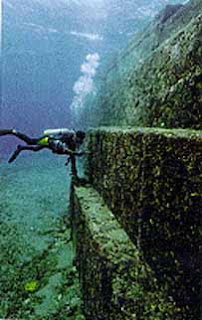 Ichthyosaurs were large reptiles that resembled fish, usually three to five metres in length, with flat, vertical tails resembling modern-day dolphins in shape. They swam with an undulatory motion which suggests they would have been too slow to pursue prey. Some species had long, tapering snouts fill with teeth but other fossils have been found without teeth suggesting that young ichthyosaurs lost their teeth on becoming adults and subsequently changing their diet. In other words, the eating habits remain a mystery until more fossils are found with their last meal preserved in their stomachs. The record for an ichthyosaur fossil was held by a 15 metre long Shonisaurus until archaeologist Keary Walde made a find on the banks of the Sikanni Chief River in Northern British Columbia in the summer of 1991.
Ichthyosaurs were large reptiles that resembled fish, usually three to five metres in length, with flat, vertical tails resembling modern-day dolphins in shape. They swam with an undulatory motion which suggests they would have been too slow to pursue prey. Some species had long, tapering snouts fill with teeth but other fossils have been found without teeth suggesting that young ichthyosaurs lost their teeth on becoming adults and subsequently changing their diet. In other words, the eating habits remain a mystery until more fossils are found with their last meal preserved in their stomachs. The record for an ichthyosaur fossil was held by a 15 metre long Shonisaurus until archaeologist Keary Walde made a find on the banks of the Sikanni Chief River in Northern British Columbia in the summer of 1991.
Embedded in the slabs of rock bordering the river was a series of huge vertebrae rising out of the stone, continuiing for a couple of metres, then disapppearing back into the limestone matrix. Some of the vertebrae still had ribs attached. This isolated area is densely wooded uneven terrain, infested with mosquitoes and home to bears. A copy of his report reached this scientist.

Elizabeth Nicholls was a specialist in extinct marine reptiles at the Royal Tyrell Museum of palaeontology in Drumheller, Alberta, Canada. She had prospected the northern British Columbian mountains since 1989 but had never come across a complete skeleton or part of a skull only a few isolated bones. When she read Walde's report and realized that the geological formation was 220 million years old and the bottom of an ancient ocean she suspected that he might have found a giant ichthyosaur from the end of the Triassic period.
It was two years later when she finally stood beside the Sikanni Chief River. It took another 3 excursions between 1999 and 2001 to extract the fossil.

Excavating the fossil was difficult because the river floods the bone site for part of the year and the blocks of limestone holding the fossil had to be helicoptered out. Some of the blocks weighed up to 4,000 kgs.
The fossil was almost complete only missing about 2 metres of backbone which held the hind limbs. Some of the bones from the tips of the front flippers were found in the ancient ocean sediments nearby. The skull had been crushed during fossilization and this weighed one and a half tonnes.
The later named Shonisaurus Sikanniensis ichthyosaur was measured by palaeontologists at 23 metres (75 feet). Its skull was 5.8 metres long and each broad, tapered flipper was 5.3 metres long.

In 2000, Elizabeth (Betsy) Nicholls was awarded a Rolex Award which financed the next four years of laboratory work to remove the limestone matrix in which the giant fossil was embedded. She believed the species likely to be the largest predator that ever lived.
Unfortunately she died from cancer at the age of 59, on October 18, 2004. The giant marine reptile she put so much work into is still being studied and part of the fossil will go on display in 2008.
A further honour was given in March, 2008. Palaeontologists from the University of Calgary named a 2.6 metre-long plesiosaur, Nichollsia Borealis, in her memory. This fossil was uncovered about 60 metres below the surface in a Syncrude mine (oil sands) near Fort McMurray, Canada. It had lived about 112 million years ago and is considered one of the most complete and best-preserved plesiosaurs from the Cretaceous Period.
It's a fitting tribute to Elizabeth Nicholls who raised two daughters before turning to palaeontology full-time and earning a doctorate on marine reptiles in 1989.
Photo 1. Artist's rendition of shonisaurus sikanniensis
Photo 2. Numbered section of the grid showing the fossil location
Photo 3. Elizabeth Nicholls
Photo 4. Conducting field work in northern British Columbia
Photo 5. Nicholls and colleague Wendy Slobada working on the skull in 1999.














